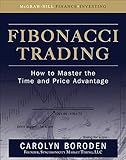Best Fibonacci Retracement Tools to Buy in December 2025

How to Make Money Trading Using the Fibonacci Retracement tool: Make Money Trading with Fibonacci



Fibonacci Trading: How to Master the Time and Price Advantage



SECRETS ON FIBONACCI TRADING: Mastering Fibonacci Techniques In Less Than 3 Days


Fibonacci retracements are a technical analysis tool used by day traders to identify potential levels of support and resistance in a price chart. It is based on the Fibonacci sequence, a series of numbers where each number is the sum of the two preceding ones.
In day trading, Fibonacci retracements are commonly used to forecast possible price levels where a stock or other financial instrument might experience a temporary reversal before continuing its primary trend. Traders plot these retracement levels on a chart by drawing horizontal lines at key Fibonacci ratios, namely 23.6%, 38.2%, 50%, 61.8%, and 78.6%.
The 23.6% level is considered a shallow retracement, while the 61.8% level is seen as deeper. The 50% level is not a Fibonacci ratio but is often included as it represents a common reversal area. These levels are derived by drawing a trendline between a significant low and a significant high on a price chart.
When a stock is in an uptrend, a trader may look for potential support levels at the Fibonacci retracement levels if a price pullback occurs. Conversely, in a downtrend, these levels may act as resistance when a stock bounces up during a bearish market environment.
By identifying these levels, day traders can set up buy or sell orders at these targeted areas of support or resistance. They often use additional technical indicators or chart patterns to confirm their trading decisions.
It is important to note that Fibonacci retracements are not foolproof, and traders should not solely rely on them for making trading decisions. They should be used in conjunction with other analysis tools and techniques for higher probability trades.
Overall, Fibonacci retracements provide day traders with potential levels to enter or exit trades, allowing them to better manage risk and maximize profit potential based on historical price patterns.
How to use Fibonacci retracements in conjunction with volume analysis?
To use Fibonacci retracements in conjunction with volume analysis, you can follow these steps:
- Identify a significant price move: Look for a substantial upward or downward movement in the price chart that you want to analyze using Fibonacci retracements.
- Apply Fibonacci retracement levels: Draw the Fibonacci retracement levels on the price chart by connecting the high and low points of the significant price move with a trend line. The most commonly used levels are 38.2%, 50%, and 61.8%.
- Analyze volume data: Look at the volume data corresponding to each Fibonacci retracement level. Volume represents the number of shares or contracts traded during a particular period, indicating the level of market interest in the asset. Higher volume usually indicates stronger buying or selling pressure.
- Identify convergence or divergence: Compare the volume at each Fibonacci retracement level with the average volume during the significant price move. If the volume is significantly higher at a specific retracement level, it indicates that there is a strong level of market interest and potential support or resistance at that level. This is known as volume convergence. Conversely, if the volume is significantly lower at a certain retracement level, it suggests that there might be less market interest and weaker support or resistance. This is known as volume divergence.
- Monitor price and volume interactions: Watch for any price action that aligns with the Fibonacci retracement levels and volume convergence or divergence. For example, if the price bounces off a Fibonacci retracement level with high volume, it may indicate a potential reversal or support/resistance level. On the other hand, if the price breaks through a retracement level with low volume, it can suggest a weak level of support or resistance.
Remember, Fibonacci retracements and volume analysis are tools that can complement each other, but they should not be relied upon solely. Consider using additional technical indicators or fundamental analysis to confirm any potential trading decisions.
What is the Fibonacci retracement tool?
The Fibonacci retracement tool is a technical analysis tool used in trading and investing to identify potential levels of support and resistance in a price chart. It is based on the Fibonacci sequence, a series of numbers where each number is the sum of the two preceding ones (e.g., 0, 1, 1, 2, 3, 5, 8, etc.).
In the context of the Fibonacci retracement tool, certain ratios derived from the Fibonacci sequence (such as 0.382, 0.500, 0.618, etc.) are used to draw horizontal lines on a price chart. These lines indicate potential levels where a price might reverse or consolidate after a significant move. They are drawn by selecting a high and low point of a price movement and then dividing the vertical distance by the Fibonacci ratio levels.
Traders and investors use the Fibonacci retracement tool to identify potential entry or exit points for their trades, as well as to determine the strength of a price trend. The idea is that price movements often follow certain patterns consistent with the Fibonacci ratios, and these retracement levels can help traders make more informed decisions.
What are the limitations of Fibonacci retracements in day trading?
While Fibonacci retracements are a popular tool in technical analysis, they do have certain limitations in day trading:
- Subjectivity: There is a certain level of subjectivity when it comes to identifying the correct swing highs and swing lows to plot Fibonacci retracements. Traders may have different interpretations, resulting in variations in the placement of levels.
- Lack of accuracy: Fibonacci retracements are based on the assumption that markets move in a predictable manner, adhering to specific ratios. However, markets can be influenced by a range of factors, and price movements may not always conform to Fibonacci levels, leading to false signals.
- Repainting: In day trading, fast-moving markets and the intraday volatility can often lead to price levels constantly changing and retracements resizing or disappearing. This can result in incorrect retracement levels, making it challenging to rely on them for decision making.
- Insufficient as standalone indicators: Fibonacci retracements are best used in conjunction with other technical indicators, such as trend lines, moving averages, or oscillators. Relying solely on Fibonacci retracements may not provide enough information for effective trade setups.
- Lack of predictive capacity: Fibonacci retracements are primarily used to identify potential support and resistance levels for price reversals. However, they do not guarantee future price movements, and traders should be cautious about relying solely on Fibonacci levels for making trading decisions.
- Application across different timeframes: Fibonacci retracements can be sensitive to the timeframe being analyzed. What may seem like a significant retracement on a shorter timeframe may appear insignificant on a longer timeframe, leading to different levels being identified.
In conclusion, while Fibonacci retracements can be a useful tool in day trading, they should be used in conjunction with other technical analysis tools and be aware of their limitations for an effective trading strategy.
How to adjust Fibonacci retracement levels based on recent price action?
Adjusting Fibonacci retracement levels based on recent price action involves re-drawing the retracement levels based on new swing highs and lows formed in the market. Here's a step-by-step guide:
- Identify the recent swing high and swing low in the price action. These are the two most significant points that will be used to determine the retracement levels.
- Draw the Fibonacci retracement tool from the swing high to the swing low. The retracement levels (usually displayed as percentages) will be automatically generated by the charting software.
- Monitor the price action and observe if there are any new swing highs or lows formed. These new swing points could potentially change the retracement levels.
- If a new swing high is formed, redraw the Fibonacci retracement tool from the most recent swing high to the swing low. The new levels will be different from the original retracement levels.
- Similarly, if a new swing low is formed, redraw the Fibonacci retracement tool from the most recent swing high to the new swing low.
- Continue repeating steps 3-5 to adjust the Fibonacci retracement levels based on the most recent swing points in the price action.
Remember that Fibonacci retracement levels are used to identify potential support and resistance areas. By adjusting the tool based on recent price action, you can ensure the levels remain relevant and aligned with the current market conditions.
